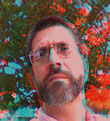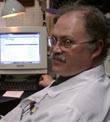|
|
This topic comprises 2 pages: 1 2
|
|
Author
|
Topic: Ballantyne flicker
|
|
|
|
|
|
|
John Pytlak
Film God

Posts: 9987
From: Rochester, NY 14650-1922
Registered: Jan 2000
|
 posted 05-20-2001 06:50 AM
posted 05-20-2001 06:50 AM





"Flicker" usually has nothing to do with the shutter timing. Excessive screen luminance makes shutter flicker more visible, so be sure the screen luminance does not exceed the 12-22 footlambert range allowed by SMPTE 196M. To virtually eliminate shutter flicker, use a 3-blade shutter to raise the interruption rate from 48 cycles to 72 cycles. But a 3-blade shutter is only half as efficient as a 2-blade shutter, so you will need twice the lamp power to maintain the same light level.Many studio and lab screening rooms use 3-blade shutters because they want to completely eliminate flicker, and the relatively small screens don't require very high light output to maintain the aim of 16 footlamberts. A home screening room likewise is a good place to use 3 blades. Large screens need lots more light, so 3-blades are impractical for very large screens. Sometimes, even if there is no visible flicker without the shutter running, and an annoying 12 Hz flicker when running, the problem is AC ripple in the lamp power supply. The 48 or 72 cycles of the shutter "beat" with the 60 Hz. AC ripple component, showing up as a 12 cycle flicker. If you have TRAVEL GHOST, then check the shutter timing. ------------------
John P. Pytlak, Senior Technical Specialist
Worldwide Technical Services, Entertainment Imaging
Eastman Kodak Company
Research Labs, Building 69, Room 7419
Rochester, New York, 14650-1922 USA
Tel: 716-477-5325 Cell: 716-781-4036 Fax: 716-722-7243
E-Mail: john.pytlak@kodak.com
Web site: http://www.kodak.com/go/motion
| IP: Logged
|
|
|
|
|
|
|
|
Rick Long
Jedi Master Film Handler
Posts: 759
From: Toronto, Ontario, Canada
Registered: Nov 1999
|
 posted 05-21-2001 12:05 AM
posted 05-21-2001 12:05 AM




Gonna assume that you projected light without the projector running (shutter blade out of the way, and the change-over blade held open with a coat-hanger). It the light appears steady, the bulb is probably not at fault. Now, if when the projector is running, you obseve noticeable flicker, I would think it is probably the result of the 48 Hertz exposure from the projector, "beating" with the 60 Hertz ripple from the rectifier. This would likely be caused by a failing filter capacitor in the rectifier. It can be proved by parallelling the existing capacitors with another unit of the same size (micro-fard (uuf) and votage rating). As has been mentioned, in a rectifier that passes spec, "shutter beat" can be noticed if the screen illumination is excessive.
| IP: Logged
|
|
Paul G. Thompson
The Weenie Man

Posts: 4718
From: Mount Vernon WA USA
Registered: Nov 2000
|
 posted 05-21-2001 12:31 AM
posted 05-21-2001 12:31 AM




Scott, we still don't have all the information. It was not indicated what voltage and current the lamp is being operated with.Rick and John, in addition to what you gents said, there is a possibility of a bad diode in Scott's power supply. But nobody knows yet with the info we have, because nobody hinted about the current and voltage at the lamp. It could be the 12hz strobe he is seeing. We'll just have to wait and see until Scott gives us more information. I never had the problem like Scott's when using a 2000 watt lamp on a Pro-35....But yes, Gordon may be correct when he said "too much light". I believe Gordon is also correct about the availability of a three wing shutter or a drive-in shutter. Unfortunately, some theaters have the local machine shop "butcher" the shutter and re-balance it for a drive-in application. After reading Scott's original post on the way the shutter is positioned before and after pull-down, he either has too much light on the screen - or there is a ripple problem due to bad filtering or a blown diode. But here again, I don't know if his problem is on just one or both machines, and when it started. It is possible that if he throttles his bulb back a little, his problem might go away if it is just "too much light", or use a 1600 watt lamp.
| IP: Logged
|
|
|
|
|
|
Scott Balko
Expert Film Handler

Posts: 136
From: Redwood Falls, Minnesota, USA
Registered: Apr 2000
|
 posted 05-21-2001 06:46 PM
posted 05-21-2001 06:46 PM




Sorry I haven't been able to give you all the information you need. Film is just a hobby for me and my job (not film related) takes most of my time on weekdays.First off, I wasn't referring to a ghosting problem. I hope I didn't confuse anyone. My problem is definitely a shutter flicker. If I leave the light on through the aperture and shut the motor off, the flicker follows the speed of the shutter to a tee. I know that I definitely need to put in smaller lamps for one thing as my power supplies are only rated for 1600 watts. They have been modified with the cooling fans for higher continuous output, but it simply isn't enough. I'm also still in the setup mode, so I haven't been able to do a direct side by side comparison. The one thing I did notice, however, is that the power supply I've been refering to won't hold a steady amp or voltage reading. The amperage will drop slightly and at the exact time the voltage will increase slightly. The other lamp/power supply combination was rock steady. From this sketchy description, is it possible to determine if the problem is in the lamphouse or the power supply? My next step was going to be to switch the power supplies and see if that changes anything. Will a 1500-1600 watt lamp go directly in place of the 2000? If so, anyone wanna trade? BTW, I liked the comment about the "Amature 35".
| IP: Logged
|
|
|
|
John Pytlak
Film God

Posts: 9987
From: Rochester, NY 14650-1922
Registered: Jan 2000
|
 posted 05-21-2001 08:06 PM
posted 05-21-2001 08:06 PM





Rick:A black or anodized shutter blade will absorb the energy, rather than reflecting it back to the lamphouse. So although there will be less stray light bouncing around to deal with, it may run hotter (and be more prone to warp or be damaged by the radiant energy). I don't think it will affect timing and travel ghost, unless there is so much stray light bouncing around that the film is somewhat illuminated during pulldown. ------------------
John P. Pytlak, Senior Technical Specialist
Worldwide Technical Services, Entertainment Imaging
Eastman Kodak Company
Research Labs, Building 69, Room 7419
Rochester, New York, 14650-1922 USA
Tel: 716-477-5325 Cell: 716-781-4036 Fax: 716-722-7243
E-Mail: john.pytlak@kodak.com
Web site: http://www.kodak.com/go/motion
| IP: Logged
|
|
|
|
|
|
All times are Central (GMT -6:00)
|
This topic comprises 2 pages: 1 2
|
Powered by Infopop Corporation
UBB.classicTM
6.3.1.2
The Film-Tech Forums are designed for various members related to the cinema industry to express their opinions, viewpoints and testimonials on various products, services and events based upon speculation, personal knowledge and factual information through use, therefore all views represented here allow no liability upon the publishers of this web site and the owners of said views assume no liability for any ill will resulting from these postings. The posts made here are for educational as well as entertainment purposes and as such anyone viewing this portion of the website must accept these views as statements of the author of that opinion
and agrees to release the authors from any and all liability.
|

 Home
Home
 Products
Products
 Store
Store
 Forum
Forum
 Warehouse
Warehouse
 Contact Us
Contact Us




 Printer-friendly view of this topic
Printer-friendly view of this topic





 ) be advisable if the shutter was rebalanced afterward, or wouldn't that even make a difference?
) be advisable if the shutter was rebalanced afterward, or wouldn't that even make a difference? 









